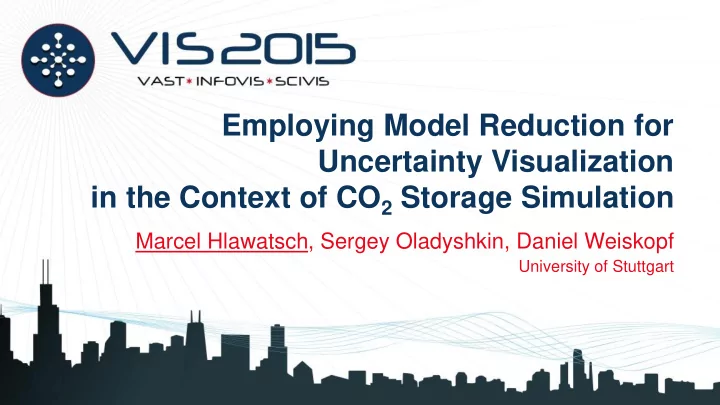

Employing Model Reduction for Uncertainty Visualization in the Context of CO 2 Storage Simulation Marcel Hlawatsch, Sergey Oladyshkin, Daniel Weiskopf University of Stuttgart
Problem setting - underground CO 2 storage • Decision making • Controversial • Impact vs risks • Public opinion • Experiments Carbon dioxide • difficult, expensive storage • only small scale, e.g., porosity tests • Simulations are important
Simulation • Modeling of storage site hard to obtain real site conditions ? ? ? • Uncertain parameters • Boundary pressure ? ? • Barriers • … • Monte Carlo approach
Uncertainty visualization Simulation Simulation • Ensemble data • Detailed analysis • Large, visual overload Dataset • Stochastic data (mean, std. dev. etc.) • Smaller data, less visual load • Aggregated • Steering • Interactivity on model level Visualization • Fast simulation, often inaccurate • Aggregation expensive • Possible to get all good properties? • Stochastic model reduction! User
Polynomial chaos expansion (PCE) • Approximation of model dependence on input • Original PCE – Gaussian distribution of input [Wiener 1938] • Arbitrary polynomial chaos (aPC) [Oladyshkin 2011] • Generalization • Incorporation of real probability distributions • Stochastic quantities “for free”: mean, standard deviation • Different evaluation of PCE data • Aggregation of ensemble not required
PCE details • Model response: projection on polynomial basis [ Ashraf 2013 ] 𝑜 𝑑 Γ - model response Γ(𝒚, 𝑢, Θ) ≈ 𝑑 𝑗 (𝒚, 𝑢) ∙ Π 𝑗 (Θ) 𝒚 - spatial position 𝑗=1 𝑢 - time Θ = [𝜄 1 , … , 𝜄 𝑜 ] – 𝑜 input parameters 𝑜 𝑑 - number of expansion terms space, time input param 𝑑 𝑗 - expansion coefficients Π 𝑗 - polynomials for input parameters Θ • More details in [Oladyshkin 2012]
Computation of PCE data • Different techniques to obtain expansion coefficients 𝑑 𝑗 • Intrusive techniques – modification of simulation code • Non-intrusive techniques – simulation is black box • Here: non-intrusive – probabilistic collocation method (PCM) • 𝑜 𝑑 simulation runs 𝑜 𝑑 = 𝑒 + 𝑜 ! 2+4 ! • collocation points from here: 𝑜 𝑑 = 2!4! = 15 𝑒! 𝑜! most probable region of input parameter distribution 𝑜 𝑑 Γ - response values 𝑑 Γ 𝑑 − 𝑑 𝑗 Π Θ 𝑑 = 0 Θ 𝑑 - collocation points 𝑗=1
PCE data and visualization • Field of expansion coefficients • Evaluate polynomials with coefficients and input parameters to obtain result 𝑜 𝑑 2 … Γ(𝒚, 𝑢, Θ) ≈ 𝑑 𝑗 (𝒚, 𝑢) ∙ Π 𝑗 (Θ) Π 𝑗 Θ = 𝑏 0,𝑗 + 𝑏 1,𝑗 𝜄 𝑜 + 𝑏 2,𝑗 𝜄 𝑜 𝑗=1 • PCE data on GPU, standard ray casting approach • 40 fps on middle class machine (818 x 466 viewport)
Visualization • Different quantities • CO 2 Saturation • Pressure • Std. deviation • Interactivity • View settings • Time series • Input parameters • Averaging of parameters • Rainbow color map – engineers like it ;-)
Experiences • Experts • Standard: static snapshots, ROIs, Plots no interactivity • Now: interactive exploration • Public • Open house events • Visitors played with application • Initiated discussion about technology • However: no direct relation to peoples’ everyday life
Decision making Do it! 65% • Trade-off: accuracy vs simplicity • Interactivity on model level important • Experts • Explore model • Deeper understanding • Non-experts • Simple visualization • Simple interface • Interactivity • Decision communication?
Conclusion • PCE is interesting tool • Full ensemble accessible by visualization • PCE approaches potential basis for novel uncertainty visualization techniques • Increasing number of PCE applications, e.g., emergency management simulations • Interactive visualization useful for experts and public
Thank you. Questions? References: [Ashraf 2013] M. Ashraf, S. Oladyshkin, and W. Nowak. Geological storage of CO2: Application, feasibility and efficiency of global sensitivity analysis and risk assessment using the arbitrary polynomial chaos . International Journal of Greenhouse Gas Control, 19(0):704 – 719, 2013. [Oladyshkin 2011] S. Oladyshkin, H. Class, R. Helmig, and W. Nowak. A concept for data- driven uncertainty quantification and its application to carbon dioxide storage in geological formations . Advances in Water Resources, 34(11):1508 – 1518, 2011. [Oladyshkin 2012] S. Oladyshkin and W. Nowak. Data-driven uncertainty quantification using the arbitrary polynomial chaos expansion . Reliability Engineering & System Safety, 106:179 – 190, 2012. [Wiener 1938] N. Wiener. The homogeneous chaos . American Journal of Mathematics, 60(4):pp. 897 – 936, 1938.
Recommend
More recommend